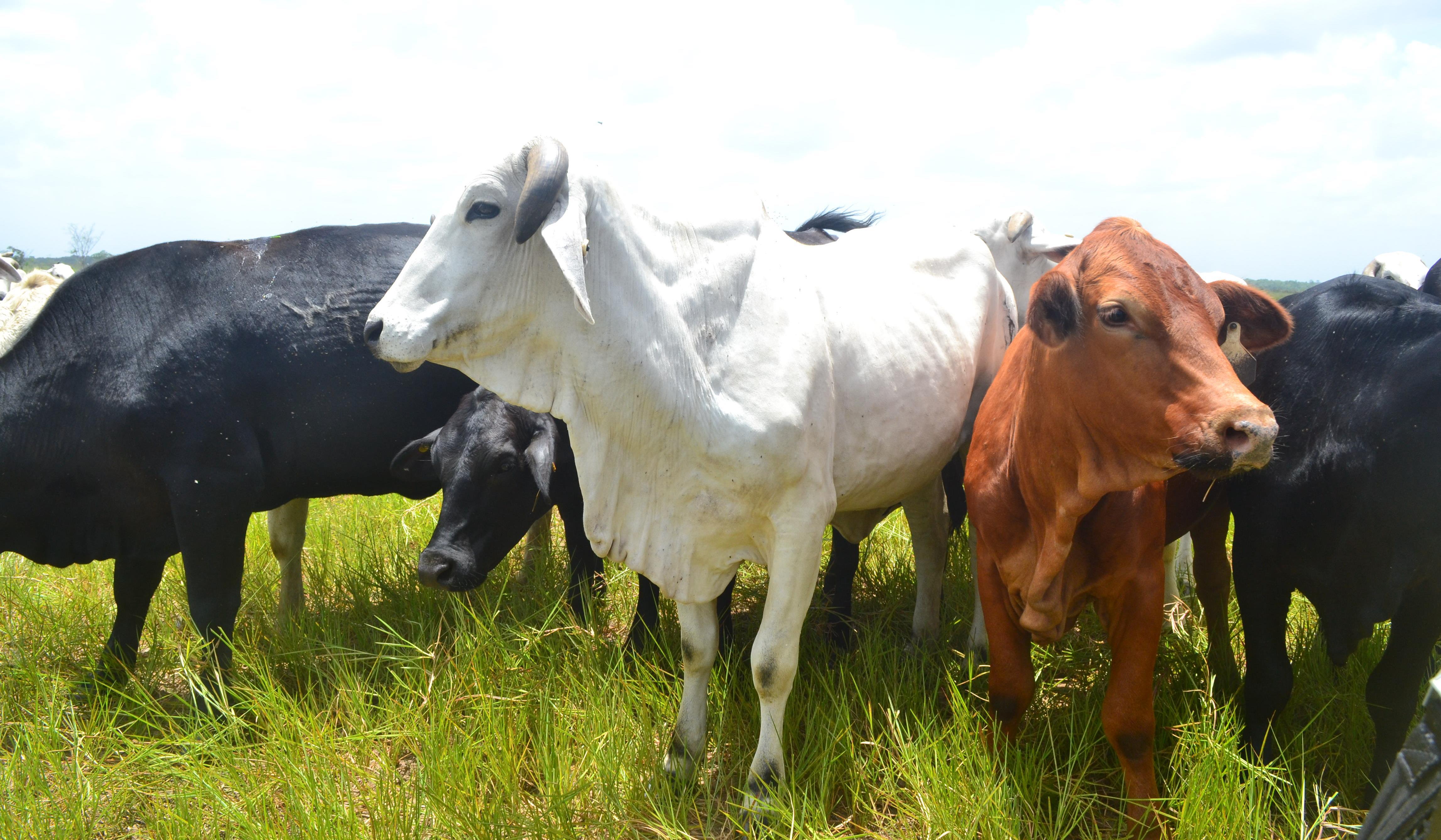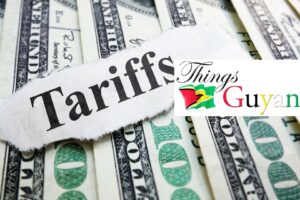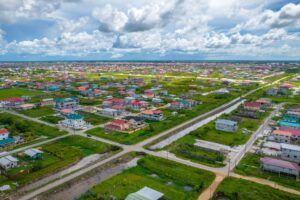When you explore the beautiful country of Guyana, you are sure to find cows almost everywhere. The cattle rearing business is a large investment for many. A lot of farmers rear cows to make a living, to provide for their family and to get food (milk and meat). Truly, we can say that the cattle industry has a major impact on the lifestyle of many people in Guyana.
Cattle are commonly raised as livestock for meat (beef or veal), for milk, and for hides, which are used to make leather. They are used as riding animals and draft animals (oxen or bullocks, which pull carts, plows and other implements). Another product of cattle is dung, which can be used to create manure or fuel. In some regions, such as parts of India, cattle have significant religious meaning. Cattle, mostly small breeds such as the Miniature Zebu, are also kept as pets.

Cattle in the Rupununi
How The Cattle Industry Began In Guyana
In the 1800s, cattle began to arrive in the Rupununi as an extension of Brazilian ranching activities. The initial impacts of this ranching economy upon the Indigenous people of the Rupununi greatly changed their traditional way of life.
In 1920, a cattle trail was opened to bring beef to the Guyanese market which connected the region to the country’s capital and exposed the people of the Rupununi to coastal people, politics and pressures.
In 1924, a British Guiana report stated, “There are very extensive savannahs tracts in the far interior on which at present cattle are being raised. With the provision of the Rupununi Cattle Trail in 1920, it is possible that this region will become the important cattle-raising section of the colony. The number of cattle in the country in 1921 was estimated to be 122,886, the number of horses 1,762, sheep 20,602, and pigs 12,312.”
In the 1930s, Guyana was opened to air traffic. Regular shipments of beef from the Rupununi to Georgetown by air began on 9th July, 1948. The Rupununi Cattle Trail came to an end with the birth of air transport and in 1953 was permanently closed. Over the years parts of the cattle trail have been upgraded today into a fair weather track and serves as a road to Brazil, through the town of Linden, ending at Lethem.
In the early 1990’s, Guyana has had a vibrant and building livestock industry. This was managed by the then Guyana Livestock Development Company, which according to the Minister, was the biggest cattle operation in the whole of the Caribbean Community (CARICOM).
At the time, Guyana was producing one-third of its milk requirements. The country was always self-sufficient in beef and was on the verge of being able to export, but the country then was not certified ‘free from foot and mouth disease’.
Additionally, the Minister speaking on the current status of the livestock industry said not much was done in the sector for the past 20 years. He said that abattoir figures show that they had been slaughtering over 50 percent of their females which can be destructive. Further, the livestock authority began to buy females at the abattoir to keep them back.
These females are then moved to Ebini in the intermediate savannahs for development, in an effort to maintain the national stock, which will then be the seed stock used to develop the industry in the Intermediate Savannahs later on.
Tip: The Dadanawa Ranch is the largest and most isolated cattle ranch in Guyana. It was sold with 300 head of cattle in the late 1880s to H.P.C. Melville. The ranch was sold to investors and established as the Rupununi Development Company in 1919.
Cattle In Guyana
Guyana is believed to have between 220,000 – 250,000 head of beef and dairy cattle. They are spread mainly in Regions 2, 3, 4, 5, 6, 9 and 10. The principal dairy producing Regions are 2, 3, 4, 5 and 6 while the main beef producing regions are Regions 3, 5, 6, 9 and 10. A 2006 census revealed that the cattle populations of Regions 5 and 6 were 69,478 and 41, 148 heads, respectively.
Maintaining The Cattle Industry In Guyana
In 2017, a team led by the Agriculture Minister Noel Holder carried out field visits to prominent cattle farms in Region Ten. One of the ranches he visited was the Mohammad Ranch – located at Moblissa, Region Ten.
The Minister said, “With the guidance of the Guyana Livestock Development Authority (GLDA), cattle farmers are now being afforded a number of technologically advanced services which will allow them to improve and increase their stock. Farmers are also now able to take advantage of expert services being offered by the authority through its extension services.” The Minister pledged government’s commitment towards rebuilding the industry. “We believe that much more can be done to improve the industry. Government is fully behind farmers and we see the potential of the industry.” Minister Holder said.
A five year plan has been developed that will see rapid increases in genetically modified stock country wide. Through the introduction of improved breeds and gained knowledge of new technology, government is seeking to ensure that the marketability of cattle is reduced from an average of four to five years to two or two and a half years.
In 2018, the cattle industry was boosted with the importation of animal stock to improve the genetics of locally available beef and dairy cattle. Also, the GLDA agency is continuing work to ensure better performance of calves produced at its Ebini outstation. Chief Executive Officer of the GLDA, Nigel Cumberbatch said, “Our breeding season begins from the 15th December to 15th March. That is the time we will put in our breeding bulls with the cows. We do this because it enables the animals to calve during the dry period of the year–September, October, November – and it gives the calves a better beginning so that they don’t calve during the rainy period and slow their growth.”
Did You Know? Guyana Livestock Development Authority (GLDA) is the agency which has responsibility for the monitoring of developments in the country’s livestock sector. It provides technical support and advisory services to all ten administrative regions of the country through a network of trained extension officers.
Cattle Industry In Guyana
If you visit the Municipal Abattoir on Water Street, Kingston, Georgetown, you would be able to see how the cows are slaughtered to provide beef, veal and hide for food and clothing. Beef is also sold at Stabroek and Bourda Market, at local markets and supermarkets, and at shops. The cow also produces delicious milk which is often sold by the milk man that rides around on his bicycle visiting various houses. Definitely, the cattle industry has a major impact on the people of Guyana.
Article References:
- https://en.wikipedia.org/wiki/Cattle
- https://agriculture.gov.gy/2017/02/16/guyanas-cattle-industry-set-to-progress-as-government-lends-a-hand-to-cattle-farmers/
- http://new.paho.org/panaftosa/index.php?option=com_docman&task=doc_download&gid=99
- http://guyanachronicle.com/2018/01/18/imported-bulls-to-aid-local-cattle-industry
- http://goinvest.gov.gy/the-savannahs-and-agricultures-future/
- https://www.jstor.org/stable/24395771
- https://www.guyanatimesinternational.com/the-historical-rupununi-cattle-trail/
- https://en.wikipedia.org/wiki/Dadanawa_Ranch
Discover more from Things Guyana
Subscribe to get the latest posts sent to your email.








3 Comments